
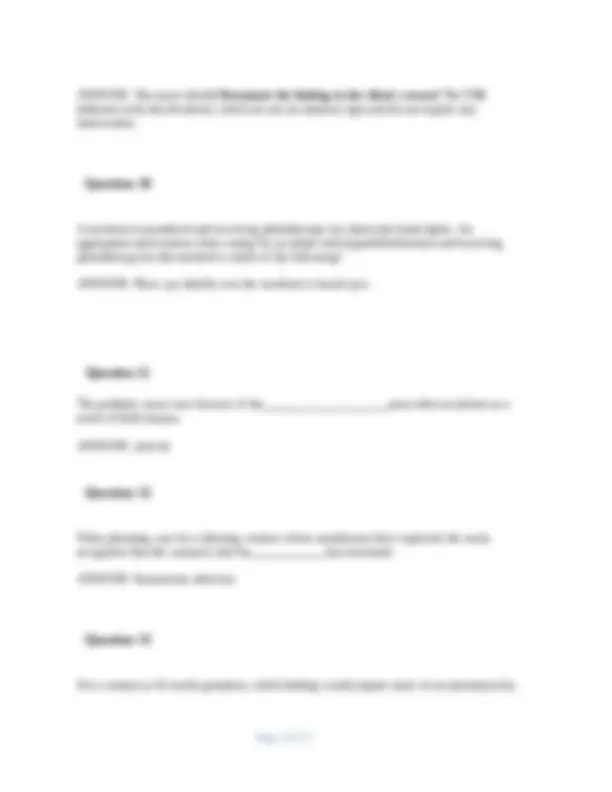
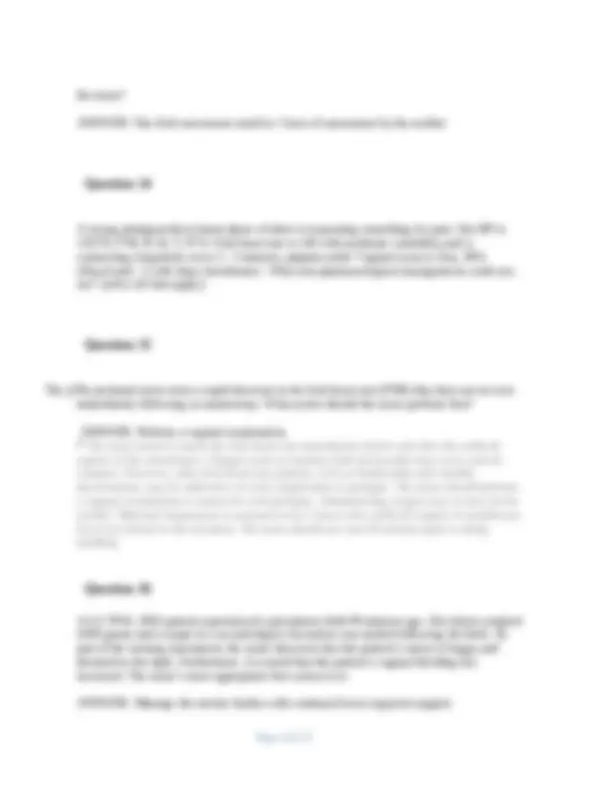
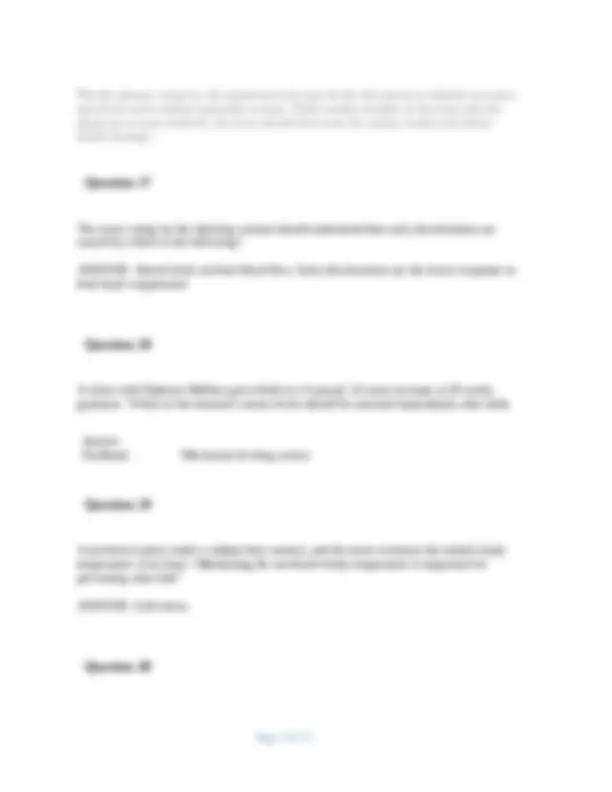
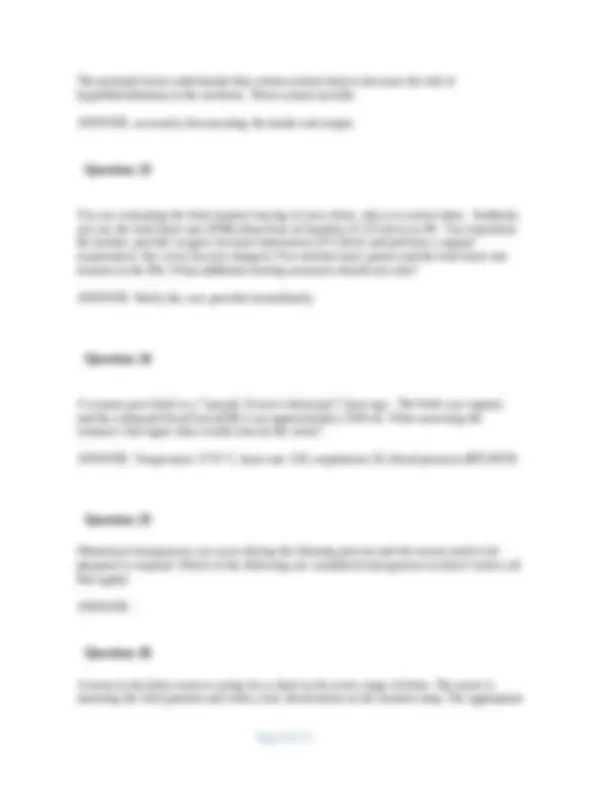
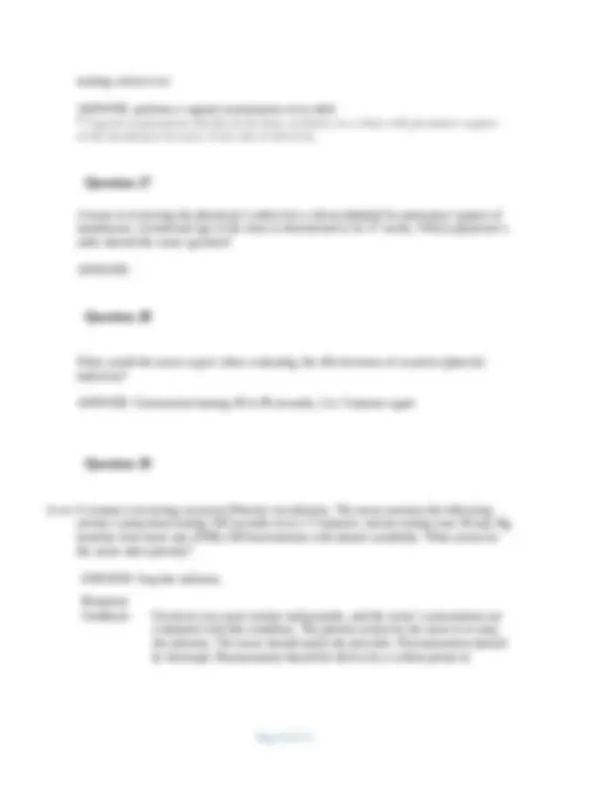
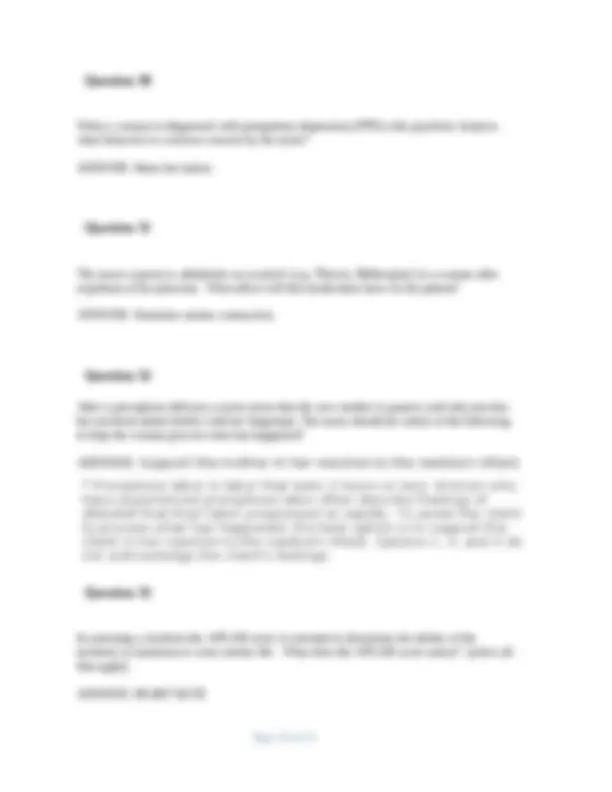
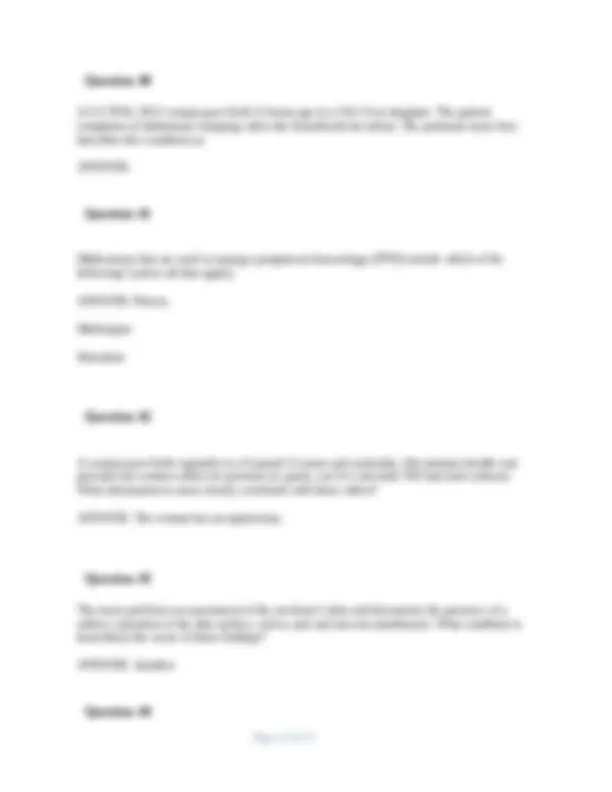
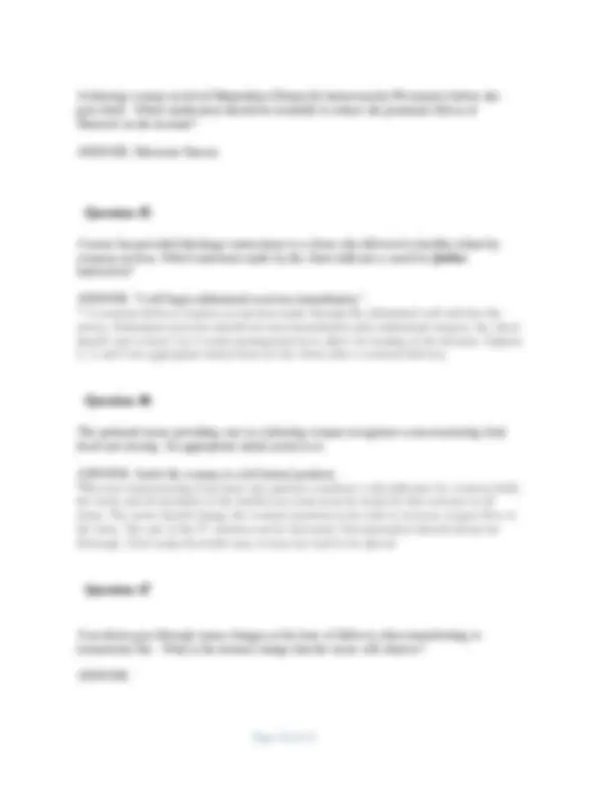



Study with the several resources on Docsity

Earn points by helping other students or get them with a premium plan


Prepare for your exams
Study with the several resources on Docsity

Earn points to download
Earn points by helping other students or get them with a premium plan
Community
Ask the community for help and clear up your study doubts
Discover the best universities in your country according to Docsity users
Free resources
Download our free guides on studying techniques, anxiety management strategies, and thesis advice from Docsity tutors
• Question 1• Question 1• Question 1
Typology: Exams
1 / 15

This page cannot be seen from the preview
Don't miss anything!










The perinatal nurse prepares the laboring woman for an epidural anesthesia insertion. In order to prevent maternal hypotension, the nurse: ANSWER: Administer an intravenous infusion of 500 mL of normal saline.
At 1 minute after birth the nurse assesses the infant and notes a heart rate of 80 beats/min., some flexion of extremities, a weak cry, slight grimacing, and a pink body but blue extremities. What is the Apgar score the nurse will calculate? ANSWER: 5
A patient with hypertension who is receiving intravenous magnesium sulfate therapy has requested an epidural anesthetic. The perinatal nurse should first review the patient’s complete blood count (CBC) results for: ANSWER: results for evidence of a decreased platelet count
After a precipitous birth the nurse encourages the woman to breastfeed her newborn. The primary purpose of this activity to do what? ANSWER: Stimulate the uterus to contract
Early this morning, an infant boy was circumcised using the PlastiBell method. The nurse
tells the mother that she and the infant can be discharged after what event occurs? ANSWER: The infant voids
According to agency policy, the perinatal nurse provides the following intrapartal nursing care for the patient with preeclampsia: ANSWER: Administer magnesium sulfate according to agency policy
A nurse is assessing a newborn born to a mother who is addicted to drugs. Which assessment finding would the nurse expect to note during the assessment of this newborn? ANSWER: Constant crying
A 30-year-old woman is being prepared for an epidural anesthesia. The perinatal nurse assists the anesthesiologist with the procedure and then positions the patient in a supine position. The patient’s blood pressure drops to 90/52 mm Hg and there is a decrease in the fetal heart rate to 110 bpm. The perinatal nurse’s best response is to: ANSWER: Place a wedge under Tanya's left hip.
While evaluating an external monitor tracing of woman in active labor, the nurse notes that the fetal heart rate (FHR) for five sequential contractions begins to decelerate late in the contraction, with the nadir of the deceleration occurring after the peak of the contraction. What is the nurse's first priority?
the nurse? ANSWER: One fetal movement noted in 1 hour of assessment by the mother
A young primigravida in latent phase of labor is requesting something for pain. Her BP is 110/70, P 90, R 18, T, 97.6. Fetal heart rate is 140 with moderate variability and is contracting irregularly every 3 - 5 minutes, palpates mild. Vaginal exam is 3cm, 90% effaced and - 2 with intact membranes. What non pharmacological management could you use? (select all that apply:)
The pThe perinatal nurse notes a rapid decrease in the fetal heart rate (FHR) that does not recover immediately following an amniotomy. What action should the nurse perform first? ANSWER: Perform a vaginal examination.
A G2 TPAL 2002 patient experienced a precipitous birth 90 minutes ago. Her infant weighed 4200 grams and a repair of a second-degree laceration was needed following the birth. As part of the nursing assessment, the nurse discovers that the patient’s uterus is boggy and deviated to the right. Furthermore, it is noted that the patient’s vaginal bleeding has increased. The nurse’s most appropriate first action is to: ANSWER: Massage the uterine fundus with continual lower-segment support.
*As the primary caregiver, the registered nurse may be the first person to identify excessive blood loss and to initiate immediate actions. While another member of the team calls the physician or nurse-midwife, the nurse should first locate the uterine fundus and initiate fundal massage.
The nurse caring for the laboring woman should understand that early decelerations are caused by which of the following? ANSWER: Altered fetal cerebral blood flow. Early decelerations are the fetus's response to fetal head compression
A client with Diabetes Mellitus gives birth to a 9 pound, 10 ounce neonate at 39 weeks gestation. Which of the neonate's serum levels should be assessed immediately after birth. Answer Feedback: Meconium for drug screen
A newborn is place under a radiant heat warmer, and the nurse evaluates the infant's body temperature every hour. Maintaining the newborn's body temperature is important for preventing what risk? ANSWER: Cold stress.
The perinatal nurse understands that certain actions help to decrease the risk of hyperbilirubinemia in the newborn. These actions include: ANSWER: accurately documenting the intake and output.
You are evaluating the fetal monitor tracing of your client, who is in active labor. Suddenly you see the fetal heart rate (FHR) drop from its baseline of 125 down to 89. You reposition the mother, provide oxygen, increase intravenous (IV) fluid, and perform a vaginal examination. the cervix has not changed. Five minutes have passes and the fetal heart rate remains in the 80s. What additional nursing measures should you take? ANSWER: Notify the care provider immediately.
A woman gave birth to a 7-pound, 6-ounce infant girl 1 hour ago. The birth was vaginal, and the estimated blood loss (EBL) was approximately 1500 ml. When assessing the woman's vital signs what would concern the nurse? ANSWER: Temperature 37.9° C, heart rate 120, respirations 20, blood pressure (BP) 90/50.
Obstetrical emergencies can occur during the laboring process and the nurses need to be prepared to respond. Which of the following are considered emergencies in labor? (select all that apply) ANSWER:
A nurse in the labor room is caring for a client in the active stage of labor. The nurse is assessing the fetal patterns and notes a late deceleration on the monitor strip. The appropriate
When a woman is diagnosed with postpartum depression (PPD) with psychotic features what behavior is a serious concern by the nurse? ANSWER: Harm her infant.
The nurse expects to administer an oxytocic (e.g. Pitocin, Methergine) to a woman after expulsion of her placenta. What affect will this medication have on the patient? ANSWER: Stimulate uterine contraction
After a precipitous delivery a nurse notes that the new mother is passive and only touches her newborn infant briefly with her fingertips. The nurse should do which of the following to help the woman process what has happened? ANSWER: Support the mother in her reaction to the newborn infant.
In assessing a newborn the APGAR score is essential to determine the ability of the newborn to transition to extra uterine life. What does the APGAR score assess? (select all that apply) ANSWER: HEART RATE
What three measures should the nurse implement to provide intrauterine resuscitation? Select the response that best indicates the priority of actions that should be taken? ANSWER: Reposition the mother, increase intravenous (IV) fluid, and provide oxygen via face mask.
The nurse is assessing a fetus using an external fetal monitor. The nurse notes that the fetus has a baseline heart rate of 125-135. The nurse would document this as: ANSWER: normal finding
The nurse has received a report about a woman in labor. The woman's last vaginal examination was recorded as 3 cm, 30%, and -2. What is the nurses interpretation of this report? ANSWER:
A G3 TPAL 2012 woman gave birth 12 hours ago to a 9 lb 13 oz daughter. The patient complains of abdominal cramping when she breastfeeds her infant. The perinatal nurse best describes this condition as: ANSWER:
Medications that are used to manage postpartum hemorrhage (PPH) include which of the following? (select all that apply) ANSWER: Pitocin. Methergine. Hemabate
A woman gave birth vaginally to a 9 pound 12 ounce girl yesterday. Her primary health care provider has written orders for perineal ice packs, use of a sitz bath TID and stool softener. What information is most closely correlated with these orders? ANSWER: The woman has an episiotomy.
The nurse performs an assessment of the newborn’s skin and documents the presence of a yellow coloration of the skin surface, sclera, and oral mucous membranes. What condition is most likely the cause of these findings? ANSWER: Jaundice
A laboring woman received Meperidine (Demerol) intravenously 90 minutes before she gave birth. Which medication should be available to reduce the postnatal effects of Demerol on the neonate? ANSWER: Naloxone Narcan
A nurse has provided discharge instructions to a client who delivered a healthy infant by cesarean section. Which statement made by the client indicates a need for further instruction? ANSWER: "I will begin abdominal exercises immediately."
The perinatal nurse providing care to a laboring woman recognizes a non-reassuring fetal heart rate tracing. An appropriate initial action is to ANSWER: Assist the woman to a left lateral position. *Because nonreassuring fetal heart rate patterns constitute a risk indicator for cesarean birth, the nurse and all members of the health-care team must be ready for this outcome at all times. The nurse should change the woman's position to her side to increase oxygen flow to the fetus. The rate of the IV solution can be increased. Documentation should always be thorough. Fetal scalp electrodes may or may not need to be placed
A newborn goes through many changes at the time of delivery when transitioning to extrauterine life. What is the normal change that the nurse will observe? ANSWER: